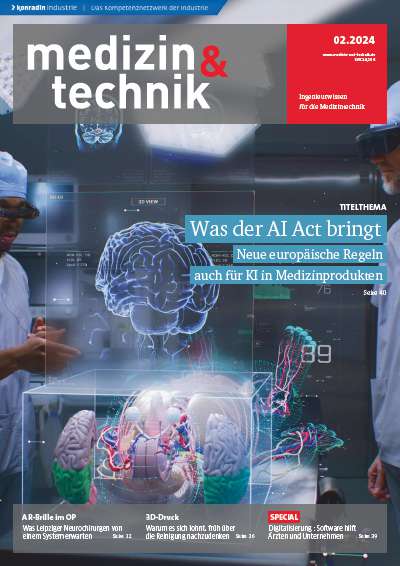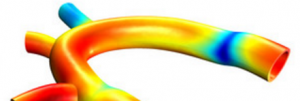CPAP generators have to have as tight of a seal as possible to provide a reliable supply of oxygen for premature babies. Manufacturer WHR Hossinger Kunststofftechnik uses the multi-sensor measuring machine O-Inspect from Zeiss to ensure that these generators are accurately manufactured, which also means guaranteeing they do not leak.
CPAP generators can save lives: they deliver oxygenated air to premature babies through a tube with slightly positive pressure. These devices help patients breathe independently and encourage the lungs to develop. The positive pressure is generated within the plastic housing of the CPAP generator. It has to be delivered to the patient without leaks by means of a silicone prong or silicone mask into the patient’s nasopharyngeal region. To expose the baby to as little stress as possible, WHR Hossinger Kunststofftechnik combines the individual plastic components of its products using a plug connection system instead of adhesive materials. All individual parts have to be manufactured with absolute precision for the CPAP generator to be tightly sealed.
Quality assurance is tasked with this part of the process, which is quite an undertaking with quantities of over 100,000 CPAP generators a year. Wall thickness of only three tenths of a millimeter, tolerances of less than a few hundredths of a millimeter, free-form parts with complex shapes, and different product colors are the challenges facing Christian Bindl, Quality Management Officer at WHR Hossinger Kunststofftechnik GmbH in Roding in Southwest Germany, and his team in measuring the components for CPAP generators.
With the previous optical measuring machine, quality assurance has been difficult, tedious, and very costly for medium-sized companies, among others, in past years. Some measurements have to be outsourced. This creates additional costs and has a negative effect on throughput times for family-owned businesses. Also, there was no room on the previously used optical measuring machine for other products produced by the manufacturer for medical technology and the automotive industry.
In 2014 Hossinger and Bindl started looking for a new measurement strategy and sought to upgrade the current optical measuring machine. They wanted to be able to measure more products in house in the future, and to do so more accurately and quicker. Their search led them to Zeiss’s O-Inspect multi-sensor measuring machine in no time.
O-Inspect combines three measuring principles into one machine: a tactile sensor, a camera sensor, and a chromatic white light sensor complement each other. The product promised not only higher accuracy, but also offered new ways to increase production. The only disadvantage: measuring 400 mm x 400 mm x 200 mm, the volume of the measuring machine was too small for Hossinger’s large-format components.
So the Bavarian company seized the opportunity to become a pilot customer for Zeiss, helping to get the next generation of the multi-sensor measuring machine ready for the market. Among other features, the new machine has a larger measuring volume of 500 mm x 400 mm x 300 mm.
“Tactile, optical, and white light sensor technology: the interaction of these three measuring methods is unbeatable because it gives us high efficiency,” praises Bindl based on his experiences in the first few months. He uses the example of one of the halves of the housing for the CPAP generator, which will later form the space in which the CPAP pressure is created. WHR Hossinger Kunststofftechnik runs the halves through a measurement at the start and end of production and performs an accompanying sample check. In manufacturing individual components, the objective is to set the switches so that there are as few rejects as possible when all CPAP generators undergo the final function test in the cleanroom.
As the first step, the O-Inspect machine scans the component tactically for about one minute: during this time, the tactile sensor records, among others, the condition and diameter of the sealing component which will attach to the tube adapter for air intake. Here it is important to maintain tolerances between one and two hundredths of a millimeter to prevent the part from leaking or breaking.
In the second step, the measuring machine switches automatically to optical measuring. Within about 1.5 minutes the camera sensor will measure the shape of the connector for the tube adapter. The half of the housing, which is yellow and semi-transparent in this version, is illuminated in blue, which is where its structure is revealed. The camera’s optical measurement is the ideal device for this task since it scans geometry elements in a fast and flexible way.
Seamlessly the machine moves on to step three of the measurement. Within only 15 seconds the chromatic white light sensor records with high precision the scatter plot of 3,000 measurement characteristics that identify the sealing shape of the half of the housing to its counterpart.
Using a multi-sensor measuring machine has paid itself off for the plastic technology specialists: WHR Hossinger Kunststofftechnik does not only have to outsource fewer measurements. Bindl and his associates can use the machine to perform a plethora of measuring tasks that would otherwise have required three measuring machines. “We doubled accuracy compared to our previous measuring machine,” reiterates the quality manager, “and without the white light sensors our measurements would take considerably more time.” As Bindl puts it, Zeiss’s O-Inspect has given the metrologists “breathing space.”
Judith Schwarz Specialized journalist in Tübingen
Multi-sensor measuring machines face the challenge of tiny free-form parts
Teilen:







